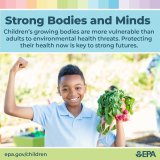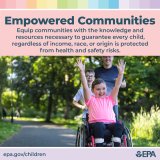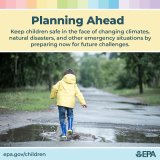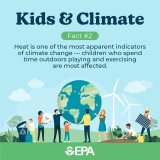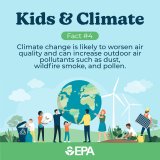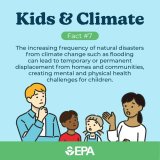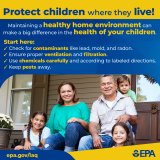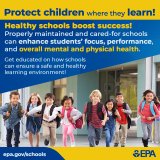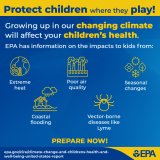Children's Health Outreach Toolkit
October is Children's Health Month!
Find factsheets, infographics, messaging, and more created for a variety of audiences and platforms about protecting children's environmental health.
Children's Health Publications
Browse EPA's published resources about children's environmental health on a range of topics including children's health activities at EPA, information for schools and educators, children's health disparities, healthy homes, and more.
Graphics
Growing Happy, Growing Healthy
Kids and Climate Health Facts
America's Children and the Environment
Protect Children Where They, Live, Learn, and Play
Childhood Lifestages
More EPA Multi-Media and Graphics
- America's Children and the Environment
- Asthma
- Children's Health Month
- Lead
- Safer Choice
- Mold
- Radon
- Cool Your Community
- Burn Wise
Children's Health Messaging
Use this messaging to help spread information and resources about children's environmental health.
Tag @epa and incorporate hashtags when using social media to stay connected: #ChildHealth, #ProtectKidsHealth.
Strong Bodies and Minds
- Children are often more vulnerable than adults to environmental hazards. They eat, breathe, and drink more relative to their body mass than adults do, and their biological systems, like their immune system, are still developing.
- Want to start learning about children’s environmental health, but don’t know where to start? Start here! This short video discusses why children are more vulnerable than adults to sources of environmental contaminants.
- Asthma cases are on the rise affecting how children play and live. You can act now to ensure kids are strong and healthy now!
- Dive into Children’s Health by the numbers. America’s Children and the Environment tool (ACE) provides data-driven insights on children’s health and the environment. ACE spotlights existing childhood health disparities and trends over time.
Healthy Spaces
- Protect your kid's health now and into the future. Check your home for pollutants like lead, mold, radon, and volatile organic compound sources.
- Healthy schools = successful students! EPA has resources to support schools and childcare facilities that are looking to improve their learning environment.
- Good indoor air quality (IAQ) in schools can foster better learning and improve student health. Schools can use the IAQ Tools for Schools to get started.
- Keep childcare centers top notch! Take the Healthy Childcare and Early Learning Facilities Self-Assessment to ensure the space is clean and healthy.
- Little changes make big differences in children's health. Switch to Safer Choice products when cleaning space where children spend their time for science-based reassurance.
Empowered Communities
- Find a children’s health expert in your community! The Pediatric Environmental Health Specialty Units (PEHSUs) are dedicated to shielding children from environmental contaminants, offer invaluable advice and resources to parents, caregivers, healthcare providers and more.
- Calling all community children’s health partners! EPA is working to get you the funds needed to ensure children are protected. Check out EPA’s Children’s Health Grants and Funding Opportunities.
- States and Territorial Health Agencies, did you know about the new Community Plan Action Templates? They can be customized based on your communities’ goals for children’s environmental health.
Bright Futures Begin Lead Free
- Get the facts about lead – check out EPA’s Protect Your Family pamphlet to protect against lead exposure in your home. Available in 12 languages.
- Have a question about lead or lead poisoning? The National Lead Information Center provides information about lead, lead hazards, and preventing lead exposure. Call them toll free at 1-800-424-LEAD [5323]
- There’s only one way to know if there’s lead in your home – by getting it tested! Talk to your health department about testing for lead in water, paint, dust and soil.
Planning Ahead
- Climate change is affecting the world where our children play and grow. Learn more about how these changes can affect children's health, and what actions you can take now to protect them.
- Play smartly! Vector-borne diseases, like Lyme disease, are on the rise. Learn how to protect children from ticks, mosquitoes and other pests.
- Climate-smart kids are future leaders! Empower them with lessons about resilience and environmental care.
- Prepare for the unexpected! Learn about best practices for protecting children during an environmental emergency like a smoke event or heat wave.

